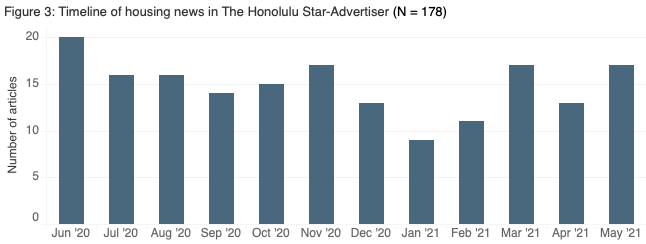Communicating for change: News about housing, equity, and health in Honolulu
Monday, July 12, 2021Our health depends on having stable, safe housing — but inequitable and unjust housing policies limit access to this vital resource for many people in our communities based on factors like race, immigration status, disability status, income-level, gender, and sexuality. The public and policymakers need to understand that housing is a public health issue and that by changing housing policy we can improve community health. News coverage is a key driver of public conversations about health and social justice issues: it influences not only whether people think about housing, but also how they think about it and what they think should be done.
As part of a larger framing analysis for Kresge's Housing and Health Equity grantees, researchers from Berkeley Media Studies Group (BMSG) are exploring questions like: How often does news from Honolulu focus on housing? Which housing issues are most often covered? And when housing appears in Honolulu news, are equity and health part of the conversation? To find out, we used the LexisNexis database to collect articles published in The Honolulu Star-Advertiser, a key local outlet, between June 1, 2020 to May 31, 2021 about issues such as affordable housing, homelessness, tenant protections, gentrification, and community land trusts.
We found that The Honolulu Star-Advertiser published 7,399 news articles between June 1, 2020 and May 31, 2021. Only 178 articles focused on housing, representing 2.4% of all news in the paper. Because housing issues are themselves interconnected, search terms were not mutually exclusive: In other words, one article could reference multiple housing issues. About half of those housing stories (104 articles) included equity or health-related terms such as "well-being," "illness," "disparities," "low-income," or "communities of color."
The Star-Advertiser's coverage tended to focus on affordable housing and homelessness while other housing issues were less visible. Advocates could pitch stories that build on this attention but expand the frame to show how housing issues are interconnected, and how they all affect health outcomes.
News about housing peaked in June 2020 with a convergence of stories about a controversial local housing development, the murder of a person experiencing homelessness, and rent waivers. We also observed a peak in March 2021 due to news about an extension of the federal eviction moratorium as well as local initiatives to address homelessness. Changes in federal, state, and local housing policy can provide windows of opportunity for advocates to communicate complex issues with the public. By monitoring news coverage, advocates can piggyback off national and state stories about housing to highlight housing issues specific to their region or city.

BMSG is continuing to analyze news coverage to inform local media advocacy campaigns to create healthy communities where anyone, regardless of what they look like or where they come from, can live in safe and stable housing. To learn more about BMSG's work on framing analysis and media advocacy for public health and social justice issues, visit BMSG.org.
Methods: Our research was informed by a survey of grantees funded by the Kresge Foundation's Advancing Health Equity Through Housing (HEH) initiative. Grantees are working across housing issues including affordable housing, homelessness, tenant protections, gentrification and displacement, and community land trusts. We used the LexisNexis archive to collect news articles from one of the highest circulation news outlets in each grantee's media market (N = 22 outlets): We used search terms related to equity or health (such as "health," "disease," "illness," "equity," "disparity," "low-income," "racism," etc.) as well as the specific housing issues named in the survey.






